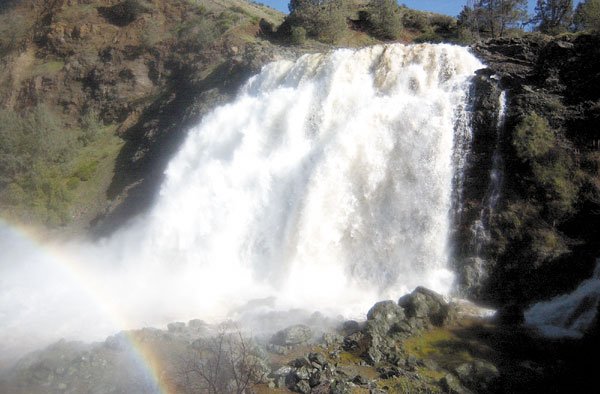Rates Rise As Water Falls
Gilroy – Since Wednesday afternoon, enough water to fulfill the daily needs of 86 families is spilling over the lip of Anderson Reservoir each second. Standing along the banks of Coyote Creek watching nearly 360,000 gallons of water a minute cascade down the spillway, it’s easy to forget that water is scarce during the summer months when temperatures soar and soil is parched.
During the winter months, the Santa Clara Valley Water District will partially open the 60-inch outlet pipes draining some of the water out of the reservoir to make room for additional rainfall. The goal is to keep the reservoir static. Letting too much into the surrounding waterways may flood downstream creeks and overestimating how much is released may produce water levels lower than intended.
“It’s a daily, sometimes hourly, balancing act using all the information out there,” said spokesperson Mike Di Marco.
Each morning, employees at the water district receive copies of the weather forecast, the tide predictions and current reservoir levels from hydrographers in the Operations Planning and Analysis Unit. They study changes and predict how much, if any, water should be released into the surrounding creeks.
One fear water district officials have is letting out too much water and overloading the creeks.
“If we make an error, we try to make it on the other side of the coin. Because once water starts flowing, you can’t stop it,” Di Marco explained.
In 1997, on Superbowl Sunday, after a period of heavy rains, water district officials miscalculated the force a wave released into Coyote Creek would cause, which flooded parts of San Jose and closed U.S. 101 near McKee Road and the Union Pacific Railroad for a few days.
However, despite the record long period of rainfall this past March, flooding is not anticipated in the areas surrounding the creeks.
Anderson Reservoir is expected to continue spilling into the next week as another cold front is forecast to bring additional rainfall to South County this weekend and late Monday.
“It’s an awesome responsibility to think that everyone in the county needs this water and nobody wants to get wet,” Di Marco said. “You can’t stay at home and monitor it.”
Hydrographers work as part of the 17-person team monitoring water levels, and some members spend their days out in the field inspecting the creeks and watching for any unusual water that may be signs of trouble ahead.
Inspectors are also aided by gauges placed underneath bridges and along the creeks that send a transmission to hydrographers alerting them if water levels have risen unexpectedly.
During this time of year, when the creeks are full, individuals often dump household appliances, furniture and waste into the waterways thinking it will be carried downstream.
“But it traps debris behind it and can cause flooding,” he said.
Santa Clara County has not had a drought in 14 years. According to Di Marco, water district officials are looking into whether additional construction needs to be made to the reservoirs to accommodate the changing weather pattern.
“The storm patterns are changing in a short period of time,” Di Marco said. “Since 1995 we’ve been having good rainfall years.”














